Motor Sizing Basics Part 4 - How to Calculate Radial Load and Axial Load
When sizing a motor, it's crucial to consider more than just torque, acceleration, speed, and inertia. Overlooking key parameters like radial and axial loads can significantly impact the performance and lifespan of your machine.
A motor's performance is defined by its torque and speed capabilities, while its structural strength is determined by its radial and axial load ratings. While torque and speed tell you if a motor can do the job, radial and axial load ratings indicate how long it can sustain that performance.
The mechanical rigidity of a motor comes from its case, flange brackets, and output shaft assembly. For gear motors, this includes gears and additional bearings. However, the bearings closest to the load bear most of the stress. Therefore, understanding radial and axial load specifications is essential for proper motor selection.
We've provided an illustration of the internal structure of an AC motor and its gearhead below. The concepts of radial and axial loads apply universally across all motor types.
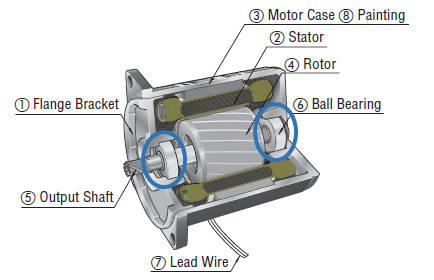 |
Starting from the inside, the rotor (4) and shaft (5) are supported by two ball bearings (6). Outside the rotor is the stator (2), with the flange bracket (1) and motor case (3) completing the outer structure. This entire assembly supports all static and dynamic forces at the rated load. |
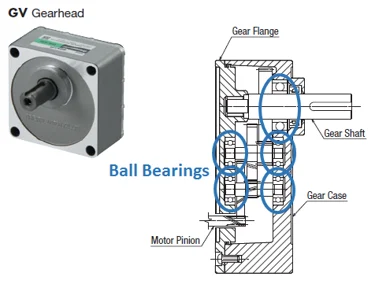 |
In a gearhead attached to the motor's pinion shaft, each gear and output shaft is supported by its own bearing, while the input shaft still relies on the motor's bearings. The bearing supporting the gear shaft is typically larger due to the higher load. The gear flange and case complete the outer structure, supporting all forces at the rated load. |
The output shaft bearing in the gearhead is generally larger than that in the motor because the load on the gearhead shaft is typically greater.
The images below illustrate both radial load (overhung load) and axial load (thrust load) acting on the shaft of a motor and a gearhead.
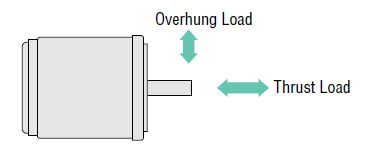
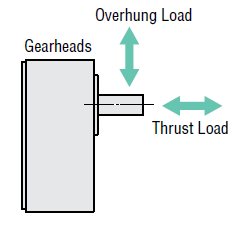
Â
| Radial Load (also known as Overhung Load) |
Radial Load is the maximum force that can be applied to the shaft in the radial direction (perpendicular to the motor shaft axis). It is also called "overhung load" because the load may "hang" off the shaft. Radial load varies depending on the distance between the installation point of the overhung load and its support bearing.
| Axial Load (also known as Thrust Load) |
Axial Load is the maximum force that can be applied to the shaft along its axis. It is also referred to as "thrust load." A typical axial load is about half the motor weight, though this has increased over time.
These forces can act in any direction.
For example, if a motor has a 100 N axial load specification, it means it can hang a 100 N load from its shaft (if the shaft is facing down) or support a load on its shaft (if the shaft is facing up). 100 N equals approximately 10 kg.
| Why Are These Specifications Important? |
Both radial and axial load specifications relate to the strength of the bearings, shaft, and case assembly. Exceeding these limits can damage the ball bearings, such as causing flaking on the raceway or breaking the output shaft.
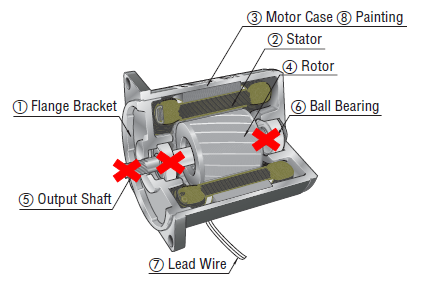 |
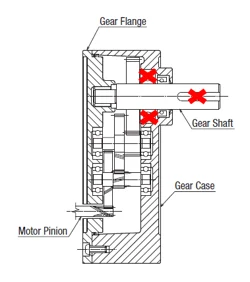 |
If the permissible radial load is exceeded, the shaft may bend and eventually break. If the axial load limit is exceeded, the bearings may deteriorate and fail. Either way, the motor will stop working or have a shorter lifespan. The component closest to the load is usually the first to fail.
|
TIP: Simple ball bearing test |
|
To check for internal damage, remove power and disassemble the motor from the gearhead, then manually rotate the shaft clockwise and counterclockwise. If damaged, you'll feel different resistance, hear abnormal noise, or not be able to rotate the shaft at all. |
The sooner the life ends depends on how much and how long the specifications are exceeded. For example, exceeding radial or axial load by 10% could reduce the bearing life by about 1,000 hours, assuming a 10,000-hour rating.
If you're interested in a service life estimation based on bearing life, contact our technical support engineers for assistance.
| How Are These Specifications Shown? |
Manufacturers may present these specifications differently. Typically, a table lists permissible radial and axial loads based on gearhead size and ratio. While the axial load remains constant, the radial load varies with the distance from the end of the gearhead output shaft.
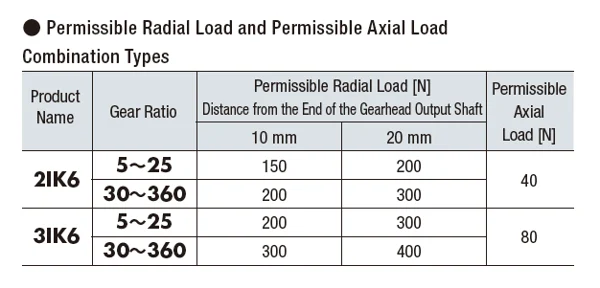
PS: This table shows permissible radial and axial loads for common geared AC motors. When using a chain, gear, belt, etc., as the transmission mechanism, the radial load is always applied on the gearhead shaft. For stepper motors, the permissible radial and axial loads are listed.
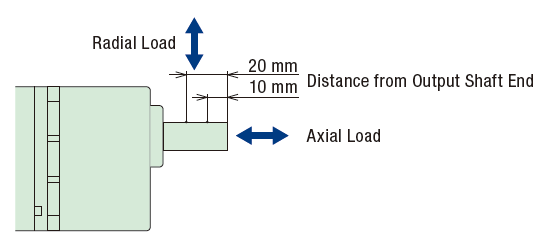
| The "SeeSaw / Fulcrum" Effect (for Radial Load) |
In the above table, you can see that the radial load changes according to the "distance from the end of the gearhead output shaft." This is the distance from the end of the load shaft to the point where force is applied (the location of the installed load). The permissible radial load increases as the distance from the end of the shaft increases because the load is closer to the support bearing inside the gearhead flange. More load can be supported when the load is "hung" closer to the support bearing, which acts as the fulcrum in this case.
A "seesaw / fulcrum" is often used to explain this concept.
Â
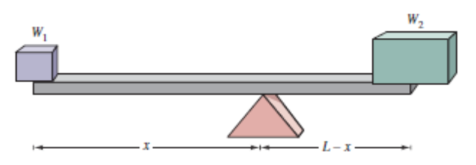
Â
Static and Dynamic Radial and Axial Loads
Similar to dynamic and static moment loads, radial and axial loads also have both static and dynamic components. The table above is used to determine both.
For example, a static radial load includes the weight of the pulley and belt tension at rest. A dynamic radial load, which requires calculation, includes forces from the same pulley weight and belt tension while in motion. A static axial load would be the weight of the pulley if the motor shaft is vertical. A dynamic axial load is typically lower, so only the static axial load is considered. Ensure that the values are under the published values in the chart.
| TIP: Remember to include belt tension as radial force |
| Remember to size for belt tension! In my experience as a technical support engineer, excessive belt tension was a frequent cause of motor problems. |
To ensure proper handling of all radial and axial loads, make sure these conditions are true:
- The static radial load is under the value in the chart.
- The dynamic radial load is under the value in the chart.
- The static axial load is under the value in the chart.
| The Equation For Dynamic Radial Loads |
For radial loads, there is an additional component of "dynamic" radial load, which is the radial load when in motion. Also make sure the calculated value is under the value in the chart (see above).
When pulleys, belts, gears, sprockets, chains, etc. are used as the transmission mechanism, the dynamic radial load is calculated with the following equation.
W = T / y
With a belt conveyor, the motor torque provides the driving force that generates work. This is shown as T, which is the amount of torque in N·m. If we consider y (effective radius in meters) to be the radius of the pulley, then we can calculate radial load or W (amount of work).
The actual equation is slightly more complicated as load coefficient and service factor are considered.

Other factors, such as drive method and load type, need to be considered for radial load. When using a flat belt drive method, for example, the radial load value increases.

As for service factor, which relates to operating conditions, factors such as frequent starting and stopping of the load as well as changing of rotation direction can affect the radial load.
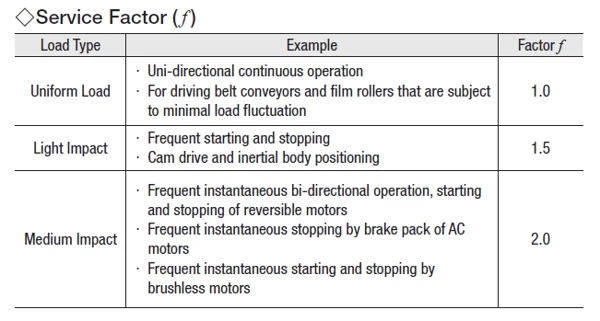
OK time for some practice.
| Example: Calculating radial load of a conveyor |
Take a look at the belt conveyor application example below. How would you calculate the value of required radial load that you'll need from the motor?
Â
I'm working on a chain and toothed (sprocket) conveyor and using a 2IK6 motor with 360:1 gearhead. I need 10 N·m of torque on an 0.1 meter (effective) diameter sprocket. I'm guesstimating that the chain tension is about 10 N. I only intend to rotate in one direction. My sprocket is mounted 10 mm from the end of the shaft.
Can my gear motor handle the radial and axial load from my application?
Â
The first questions I ask myself are: what equation do I use (we know this), and do I have all the variables?
Since we live in a perfect world, all the variables that are necessary for the calculation are laid out and provided in the preferred units. In reality, it usually takes more work. For example, notice that the load coefficient and the service factor were not given, but the drive method and type of load were given. Also, the values provided may be in different units, so an extra step of unit conversion may be needed.
Once again, we need to:Â
Make sure these conditions are true:
- The static radial load is under the value in the chart.
- The dynamic radial load is under the value in the chart.
- The static axial load is under the value in the chart.

| Static Radial Load = OK |
Static radial load would be belt tension. The 10 N was a guesstimate, but that's the best information we have right now, so we'll use it. At 10 mm from the end of the shaft, our maximum radial load for the 2IK6 motor is 200 N, so we're good here.
| Dynamic Radial Load = OK |
Plug in values for every variable in the equation for dynamic radial load.
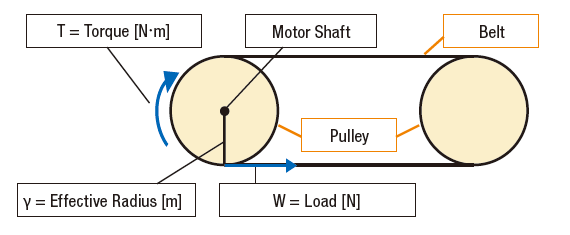

W = what we're solving for in radial load in Newtons.
K = 1; chain and toothed belt conveyor
T = 10 N·m
f = 1; uniform load / unidirectional continuous operation
y = effective radius of pulley = 0.1 meter (effective radius is where the belt contacts the pulley surface)
W = K x T x f / y
W = 1 x 10 x 1 / 0.1
W = 100 N
100 N is below the 200 N permissible radial load value, so we're good here.
| Static Axial Load = OK |
Static axial load is actually unknown at this point, but looking at the application image, we should not have a lot of static axial load, and it definitely should be below the 40 N value in the chart, so we're good here, too.
| Conclusion |
The 2IK6 motor with 360:1 gear ratio gearhead will be able to handle both radial and axial loads.
Most motor sizing software do not consider axial or radial loads, so don't forget to confirm your radial load and axial load after sizing your motor.
| Let Us Help! |
In most cases, a thorough motor sizing takes more work than you think. If your time is as valuable as we think it is, let our experts help!
To begin your motor sizing consultation with us, please use our  hbspt.cta._relativeUrls=true;hbspt.cta.load(2284573, '1726541c-dd49-4785-af36-f6786a53b911', {"useNewLoader":"true","region":"na1"}); , select one of the common applications (shown below), then fill in the blanks. A sizing report, including calculations, can be generated. Our knowledgeable technical support engineers are more than happy to analyze your motor sizing report with you to make sure you buy the right motor the first time (we do not like RMAs either).
hbspt.cta._relativeUrls=true;hbspt.cta.load(2284573, '1726541c-dd49-4785-af36-f6786a53b911', {"useNewLoader":"true","region":"na1"}); , select one of the common applications (shown below), then fill in the blanks. A sizing report, including calculations, can be generated. Our knowledgeable technical support engineers are more than happy to analyze your motor sizing report with you to make sure you buy the right motor the first time (we do not like RMAs either).
hbspt.cta._relativeUrls=true;hbspt.cta.load(2284573, '1845224e-9502-4f13-8c3b-2aa5c75abb0f', {"useNewLoader":"true","region":"na1"});
As I have mentioned before, a successful motor sizing is only as good as the information provided. Users often oversize motors because either they do not know the exact information necessary for sizing, or they want to extend the life of the motor.
In the next post, I will provide some  hbspt.cta._relativeUrls=true;hbspt.cta.load(2284573, '0db6848f-18ac-4888-89e7-bcacef169c20', {"useNewLoader":"true","region":"na1"}); . Here's also a post explaining how to
hbspt.cta._relativeUrls=true;hbspt.cta.load(2284573, '0db6848f-18ac-4888-89e7-bcacef169c20', {"useNewLoader":"true","region":"na1"}); . Here's also a post explaining how to  hbspt.cta._relativeUrls=true;hbspt.cta.load(2284573, '08e623bd-cd31-4a83-a2a7-f7a28262b927', {"useNewLoader":"true","region":"na1"}); .
hbspt.cta._relativeUrls=true;hbspt.cta.load(2284573, '08e623bd-cd31-4a83-a2a7-f7a28262b927', {"useNewLoader":"true","region":"na1"}); .
Â
Previous Posts:
Cosmetic Chemicals,Good Surfactants In Cosmetic,Custom Cosmetic Chemicals,Skin Care Conditioner Pq-6
ZHEJIANG XINHAITIAN BIO-TECHNOLOGY CO.,LTD. , https://www.dadmacxht.com